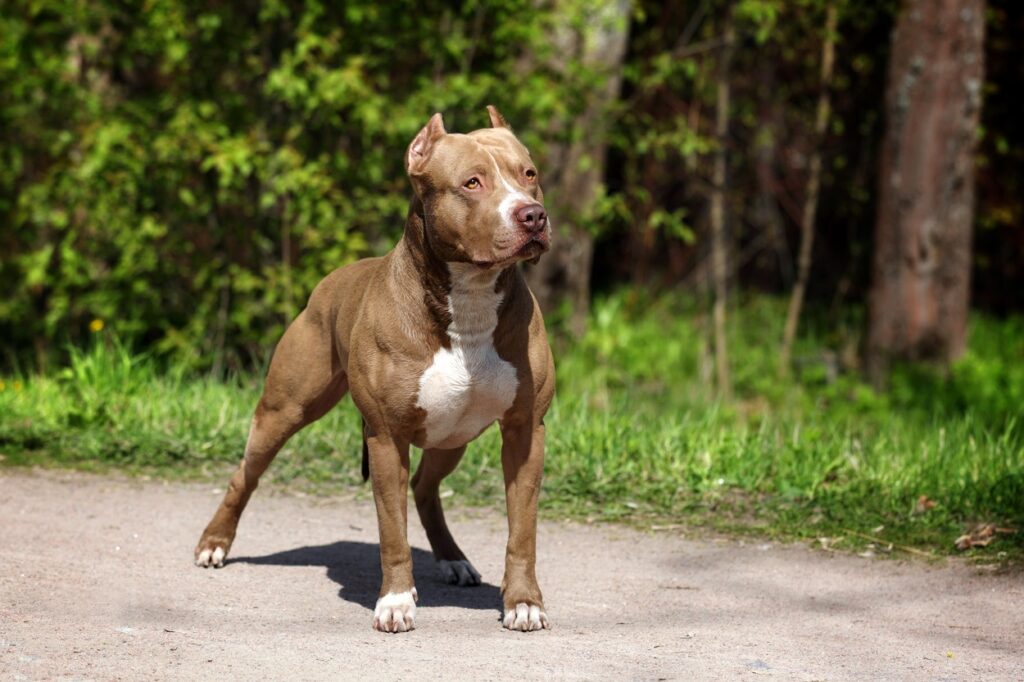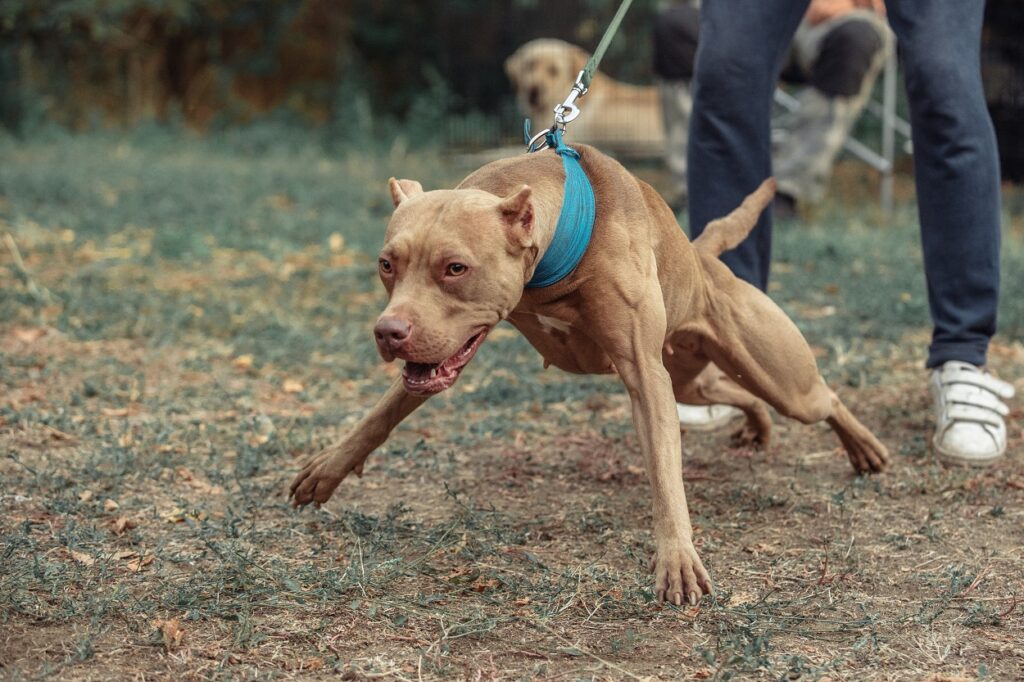Pit bulls are intimidating dogs because of their commanding appearance.
Although the AKC (American Kennel Club) does not recognize the pit bull, the organization recognizes the following breeds:
-
- American Pit Bull Terrier
- American Staffordshire Terrier
- Staffordshire Bull Terrier
- American Bully
If you have a pit bull of any of the types listed above, you’ll need to focus on more than just physical exercise if you want your pit to pack on some muscle. Today’s guide will highlight the different steps you can take to bring out the best in your pit.
Why are Pit Bulls So Muscular?
The pit bull is naturally equipped with more muscle than most breeds due to their lineage. The breed hails from both terriers and bulldogs, both breeds renowned for their solid, stocky build.
Of the pitbull breeds listed above, the American Pit Bull is widely considered to be the most muscular of all.
You can see the strength and power of pit bulls from a distance. Their shoulders and forelegs are loaded with well-defined muscle, their bodies resembling a bullet of pure muscle.
Historically, breeders have harnessed the athletic ability and strength of pit bulls by subjecting these dogs to bull baiting or dog fighting. Now these practices are both mercifully banned, the prowess of pit bulls is now showcased in weight pulling and dock jumping.
What Affects the Weight of Your Pitbull?

Before we outline how to make your pit bull as muscular as possible, take a moment to explore why your pit might not be looking as muscle-packed as you would expect.
These factors can all impact the weight and muscularity of your pooch:
- Genetics
- Lack of exercise
- Improper nutrition
- Stress or disease
- Parasitic Infection
Genetics
Just like with humans, the weight and body composition of pit bulls depend to a significant extent on genetics.
Research indicates that obesity in dogs is largely triggered by genes inherited from the parents. This explains why there is such variety among the adult weights of different breeds. No two dogs of one breed end up the exact same size when fully grown.
What this means is that you should not place undue pressure on getting your pit to pile on some lean muscle. If your dog is genetically predisposed to be slimmer, you will face an uphill struggle trying to beef him up.
Lack of exercise
When your pit is a puppy, you should train him and take him on short daily walks. As he grows, you can build up his exercise routine so that it’s more demanding.
If you fail to give your pit sufficient exercise and movement, he is almost certain to pack on the pounds, but the added weight will be fat rather than muscle. A buff pitbull requires the right diet partnered with an appropriate exercise regime.
Improper nutrition
All dogs are directly affected by the quality and quantity of food they eat. Pits are not an exception to this rule.
Your pitbull requires a diet rich in protein, carbohydrates, and healthy fats. If you dial in your pit bull’s diet when he is a puppy, this will create a firm foundation for attaining his ideal weight as an adult.
Only use treats as positive reinforcement during training. If you are too generous with these, your pit will end up becoming chubby rather than muscular.
Stress or disease
If a pit bull is stressed or depressed, this often leads to weight loss. Some common causes of dog depression include:
- Sudden changes to environment
- Separation anxiety
- Neglect
Pits who develop illness or disease also often experience changes in weight. Dental problems and diabetes can both cause abrupt weight loss. Liver disease and canine cancer will also sap your pit’s muscles.
Parasitic infection
If you pit bull is infested with parasites like hookworms or roundworms, these parasites can penetrate your dog’s system. Rather than your dog’s body absorbing the parasites, the parasites suck away the nutrients and minerals from your pup’s system, leading to weight loss and an array of other complications. Seek immediate assistance from a vet if your pit is attacked by parasites.
With that groundwork laid, you’re now ready to make your pit into a ball of rolling muscle.
How You Can Make Your Pitbull More Muscular in Five Easy Steps

While all pit bulls are unique, here are five simple ways to make yours as muscular as possible:
-
- Create and maintain and a proper diet for your pit
- Consider giving your pit some supplements
- Incorporate plenty of exercise into your pit’s daily routine
- Give your pitbull lots of high-intensity cardiovascular exercise
- Engage your pit with some weight training
1) Create and maintain and a proper diet for your pit
The most crucial element in building and maintaining muscle in your pit bull is to focus fully on nutrition. Diet is central to muscle building.
Although store-bought dog food intended for pit bulls might be filling, much of this food is lacking in nutrients. You should always provide your pit with balanced meals consisting of protein from good sources, carbs, and healthy fats. Here’s how these macronutrients help your pit to build lean muscle mass:
- Proteins: Pit bulls need a diet consisting of a minimum 40% protein. This key macro is vital for muscle growth. Protein will also help to strengthen your dog’s immune system. Chicken, beef, pork, and fish are all good sources of pit protein. Include one of these with every meal you give to Rover.
- Carbs: Carbohydrates provide your dog with the energy he needs to get through the day. Pits require 40% of their diet as carbohydrates, promoting growth of body cells and the brain. Examples of carbs for pit bulls include corn, potato, brown rice, and whole wheat.
- Fats: The remaining 20% of your dog’s diet should consist of healthy fats. This will help fuel his muscles and provide him with the capacity to perform. Add some raw eggs to each pit bull meal to achieve this.
Most pit bulls respond favorably to six small daily meals. This will promote an anabolic state ideal for muscle building. Create a scheduled routine for feeding and stick to this routine to make your pit bull muscular.
2) Consider giving your pit some supplements
Pits require lots of vigorous exercise and this can sometimes deplete crucial nutrients. It is worth adding a daily supplement to your pit bull’s meals to counter this.
Consider the following supplementation:
Vitamins, omega fatty acids, antioxidants, and protein supplements: These supplements can help to build and repair muscles, reduce pain in muscles, and decrease swelling, helping your pit to stay active and to stay muscular.
3) Incorporate plenty of exercise into your pit’s daily routine
The right diet is essential to promote pit bull muscle growth, but it is only one component of the process. Exercise is also extremely important.
You can start your pit with some simple walking or running. Once he becomes accustomed to increased levels of activity, try introducing the following activities:
- Weight pulling
- Spring-loaded poles
- Weight sleds
- Running uphill
- Weight vests
As your dog exercises, this causes tiny tears in the muscles. During the rebuilding process, adding protein to your pit’s diet will enable the muscles to repair and rebuild, becoming bigger and stronger.
Remember: dial in your pit’s nutrition before you initiate a vigorous exercise plan for your pup.
4) Give your pitbull lots of high-intensity cardiovascular exercise
Once the exercise routine starts to pay dividends and your pit is eating six balanced meals each day, introduce some cardiovascular training.
Sprinting or hill running should be limited to about ten minutes daily due to the high intensity of these cardio activities.
5) Engage your pit with some weight training
The final step in making a pit bull muscular involves some simple weight exercises.
Spring poles make great instruments for a tug-of-war with your pit bull, but always be wary of how much weight your dog can comfortably handle. You don’t want to do more harm than good. Your aim is to push your dog without taking him beyond his limits.
To boost the strength in your pit’s back and neck muscles, use a small water bottle or light dumbbell and get your dog to play fetch and carry.
Conclusion
We very much hope today’s guide has given you some actionable ways of bringing out the very best in your pitbull.
Although these dogs do not make the best choice for inexperienced or first-time pet parents, the breed is misunderstood. Properly trained and socialized, pits are surprisingly lovable.
Diet and exercise are the twin pillars for muscle-building in pit bulls, just like in humans. If you ensure that your pup gets ample exercise and six small meals each day loaded with protein, carbs, and healthy fats, you should soon notice visible muscles popping under that soft and silky coat.
Bookmark GO Boxer Rescue before you head off today and head back soon for more great guides to all aspects of dog ownership. We’ll see you soon!
